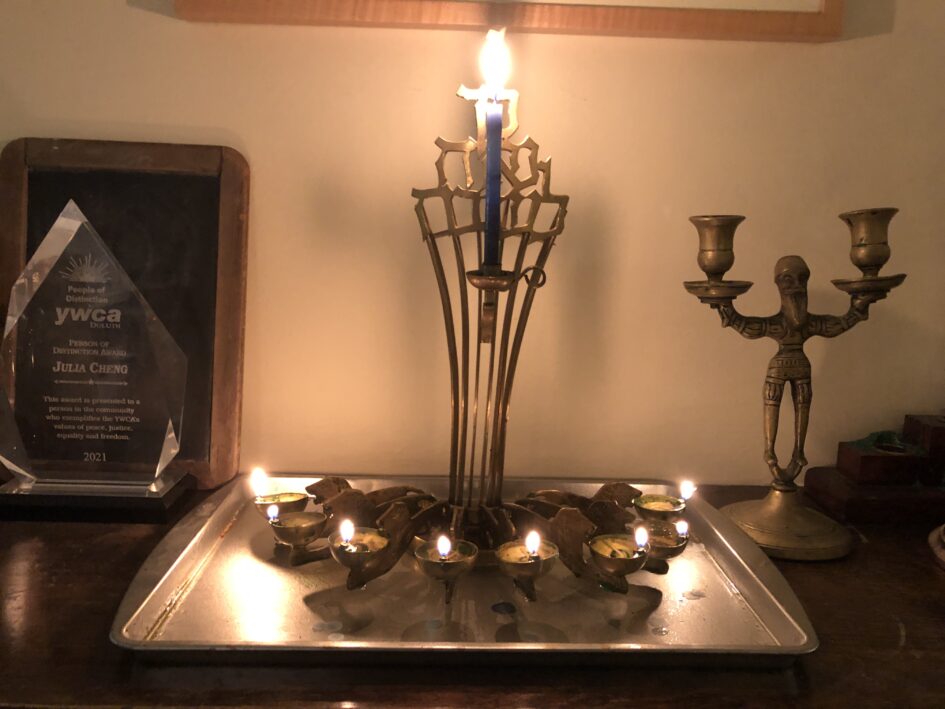The menorah was way too expensive for a 12-year-old kid, so the Hebrew bookstore in Chicago put it on layaway
Forward
By Robin Washington
December 12, 2023
I can’t remember if it was 1968 or ’69, or why my older brother Glen was visiting Albany Park, a neighborhood six miles away from our home on Chicago’s Near North Side. He doesn’t recall either, but it may have been for a chess meet at a rival high school, or because he was riding his bike on one of our endless explorations.
But I do recall him excitedly describing what he saw.
“There’s this really cool menorah,” he said of the window display at Rosenblum’s Hebrew Book Store in what was then the Jewish neighborhood — an enclave that kept shifting with Chicago’s every-changing ethnic boundaries (Rosenblum’s has since moved two more times and is now in Skokie, and online as alljudaica.com).
Eventually, I made it there, viewing through the window when the store was closed. The Hanukkiah was oil, with each cup held by swooping lions, gold or gold-plated. At 12, I was determined to buy it.
“$100,” I learned when I came back during store hours. While I’m sure they didn’t have a lot of other Black customers, I wasn’t unknown to the proprietors (we called the owner Rabbi Rosenblum, though I’ve since learned he wasn’t one). We bought our Hanukkah candles and gelt there. But this was a major purchase for a kid.
They were supportive, however, and said I could buy it on layaway with my paper route money. So after that, I’d come in once a week and plop down $5 or so, to choruses of “There he is!” and “He’s buying it for his mother.” (I never said that, but no point in arguing.)
After about 15 weeks, “Rabbi” Rosenblum said to everyone in the store: “He did it! He paid it off!”
I protested, “No, I didn’t. I only paid $70.”
“No, you paid $100. Come look,” he said, opening up a ledger that showed my payments but didn’t total the numbers.
By then, the associates were already wrapping it up. I don’t recall if they sang “Mazel Tov,” but that was the atmosphere. I stopped objecting.
At home, the menorah dusted our others that had been the basis for the competition between Glen and me over whose would burn longest. The oil way outlasted candles, burning for more than two hours. Wesson oil worked fine, though one year I tried mineral oil. Bad idea: the entire cups ignited, not just the wicks, leaving burn marks on our living room paneling.
The artist turned out to be Ludwig Wolpert, a major Bauhaus-influence creator of Judaica, and its value has increased significantly. Occasionally a sister menorah appears in an online gallery or on eBay for anyone interested in a current appraisal.
More than that, it’s an heirloom destined for my 10-year-old grandtwins. And as an adult, I deduced why they let me have it for $70: No businessman would have made that mistake. It’s far more likely that was the wholesale price, and when I reached it, Rosenblum could let this nice Jewish boy have it without taking a loss.
There’s a story bopping around the internet (and likely originating before its invention) of a little girl buying an expensive bracelet for her sister at a shop in Jerusalem. The kindly proprietor lets her have it for the shekels in her pocket, though it’s worth thousands. Later, the sister attempts to return it to correct the mistake — to which the proprietor says no, the little girl paid in full: eight shekels and a loving heart.
It’s touching, but an urban legend, of course. Nothing like the urban truth.


 WordPress
WordPress